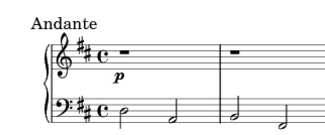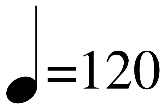Types of Beats
- Down-beat: Beats have two components – the down-beat and the up-beat. The down-beat is best understood by clapping your hands along with a song. You are clapping the down-beats.
- Up-beat: An up-beat is the part of the rhythm that occurs in between the down beats. When clapping along with music, an upbeat is timed with when you pull your hands away from each other.
- Stressed beat: The beat that is given emphasis, be that it is a little stronger, louder, or in some way stands out from the other beats. It is often (but not always) the first beat in a measure of music.
- Non-stressed beat: The opposite of a stressed beat. Often a song is filled with more non-stressed beats. For example, when the first beat in a 4/4 measure is emphasized, the other three beats are non-stressed.
How to Identify Beats in Music
When Reading Music:
There are slow songs, and there are fast ones. The speed can be indicated by either a metronome , or by using traditional Italian music terms such as Andante or Moderato, although there are many others.
Here is an example of sheet music that uses Andante:
Andante indicates a tempo of a moderately slow beat. Think of the speed at which you take a gentle walk.
Here is the other way of showing the tempo of a beat. A quarter note is given a number. This number is the setting on a metronome:
Metronomes are devices that literally keep the beat by making a repetitive sound based on the speed setting of the metronome. A great way to see how this works is to visit an online metronome web site, such as this one – https://www.flutetunes.com/metronome/
When Listening to Music:
Taking beat a bit further, let’s discuss emphasis. We tend to emphasize the downbeats. Imagine you are walking while listening to a favorite song. If your walking is timed with the beats, then each time your foot touches the ground you timed it with a downbeat in the music.
When you raise your feet you are timing with the upbeat. So literally the image of something going down and up is helpful to understand downbeats and upbeats.
Here is a video of a drummer explaining this:
Putting the emphasis on certain downbeats (or even upbeats) will alter the feel of the music. When counting beats in 4/4 time, we might emphasize the first downbeat. Imagine counting in a way in which we say one number louder than the other numbers. For example, saying “ONE – two – three -four.” It is very common to emphasize the first downbeat. A good practice is to try emphasizing other downbeats, or even more than one. As an example, it is also common to emphasize the first and third beats. In saying this out loud, it would sound like “ONE – two -THREE – four.”
To fully capture the downbeats and the upbeats try saying it like this: “One – and – two – and – three – and – four – and.” Using this approach, you can emphasize any combination of downbeats or upbeats. Try placing the emphasis on the first and third upbeats. This would be “one – AND – two – and – three – AND – four – and.”
This can get tricky to achieve. Yet practice will get you closer to doing it in a correct way.
Closing this lesson on beats, here is a video from a percussion specialist in which he shows just how to understand and emphasize the upbeats. He’s got rhythm!
No matter what instrument you play, or if you are a vocalist, you do need to follow the beat. Even if there are no percussion instruments involved, the rhythm, beat, tempo, or speed is something that applies to any music performance.

